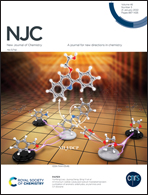A phase transition-induced photocathodic p-CuFeO2 nanocolumnar film by reactive ballistic deposition†
Abstract
In the present study, Cu–Fe–O vertical nanocolumnar structured arrays are deposited on fluorine-doped tin oxide substrates by the reactive ballistic deposition technique in an oxygen atmosphere by fixing the deposition angle at 85°. The scanning electron microscopy images show the presence of arrays of individual columns. The photocurrent density of the Cu–Fe–O sample annealed at 650 °C for 2 h in argon (CuFeO2) is determined to be −0.22 mA cm−2 at 0.4 V versus RHE in 1 M NaOH under AM 1.5 G illumination, while the same annealed in air exhibits a photocurrent density of 0.12 mA cm−2 at 1.23 V versus RHE. Here, the film annealed in an argon atmosphere at 650 °C exhibits a p-type characteristic with cathodic photocurrent, while the film annealed in air depicts an n-type characteristic with anodic photocurrent. The switch in conductivity from n-type to p-type is induced by the phase transition from amorphous Cu–Fe–O to delafossite CuFeO2. The generation of cathodic photocurrent from p-CuFeO2 is also expected to be from the presence of the Cu2+/Cu+ redox couple, which is evidenced by X-ray photoelectron spectroscopy.



 Please wait while we load your content...
Please wait while we load your content...